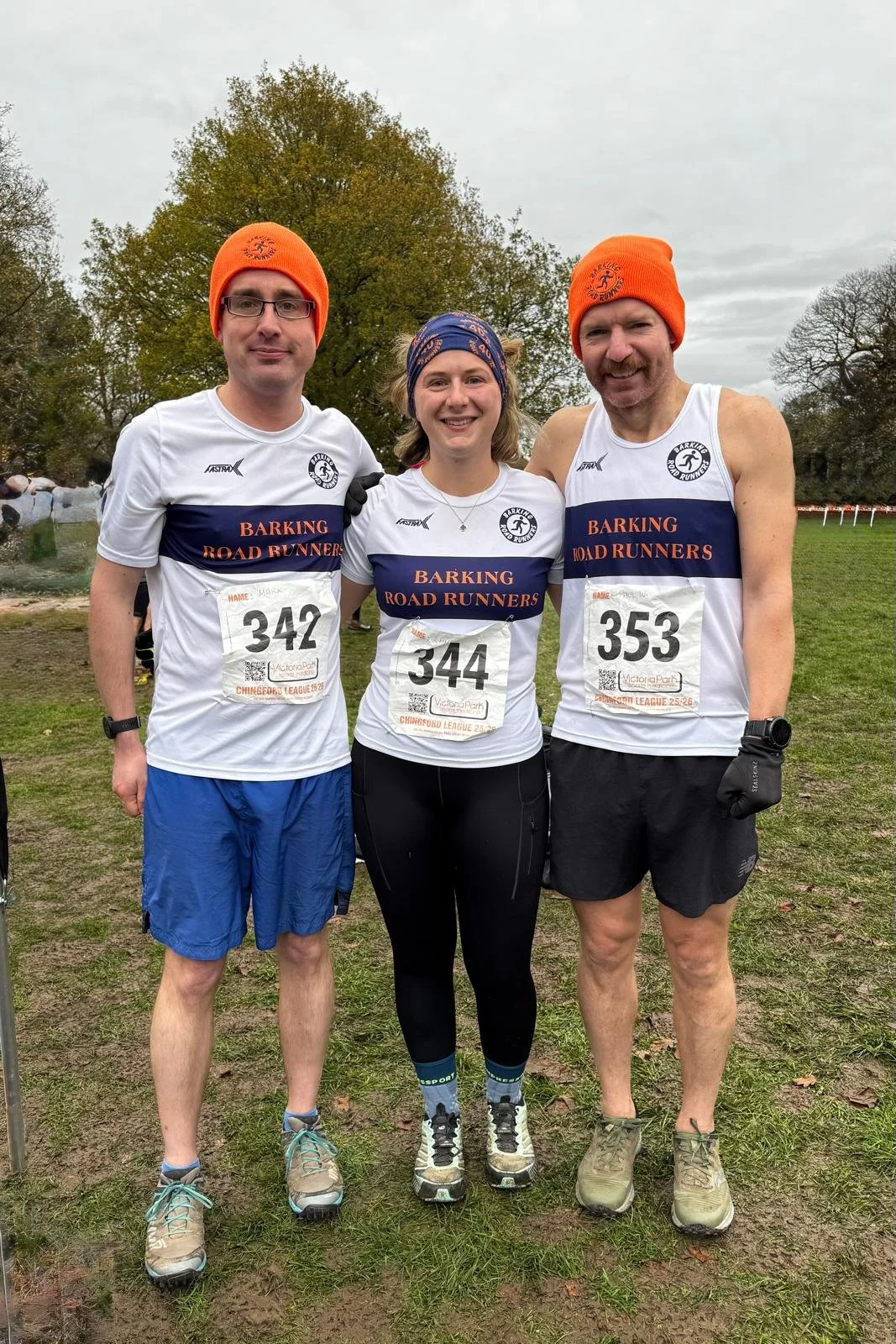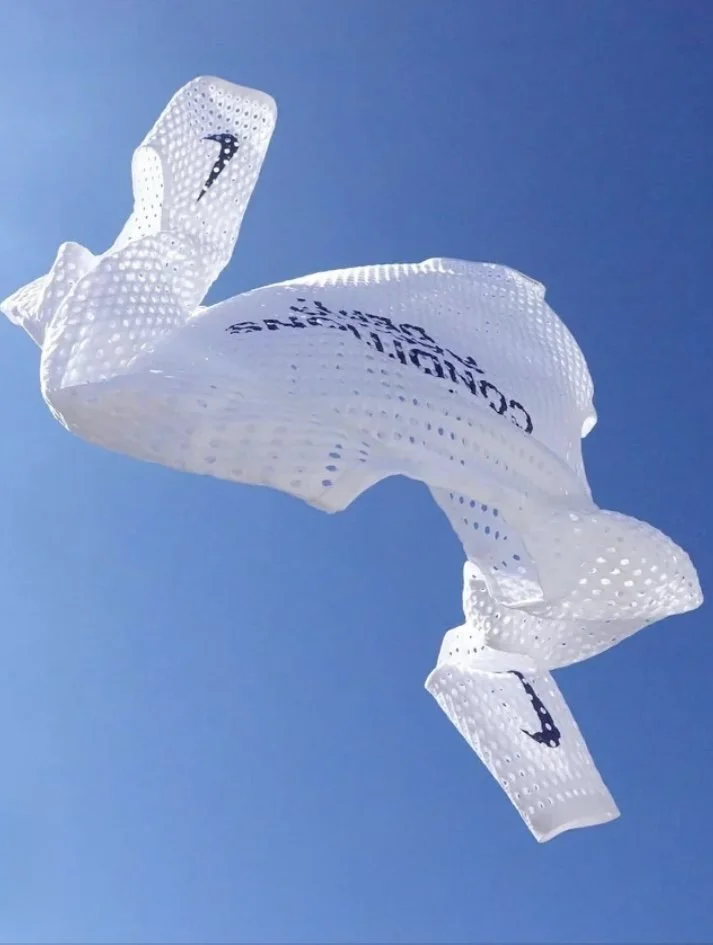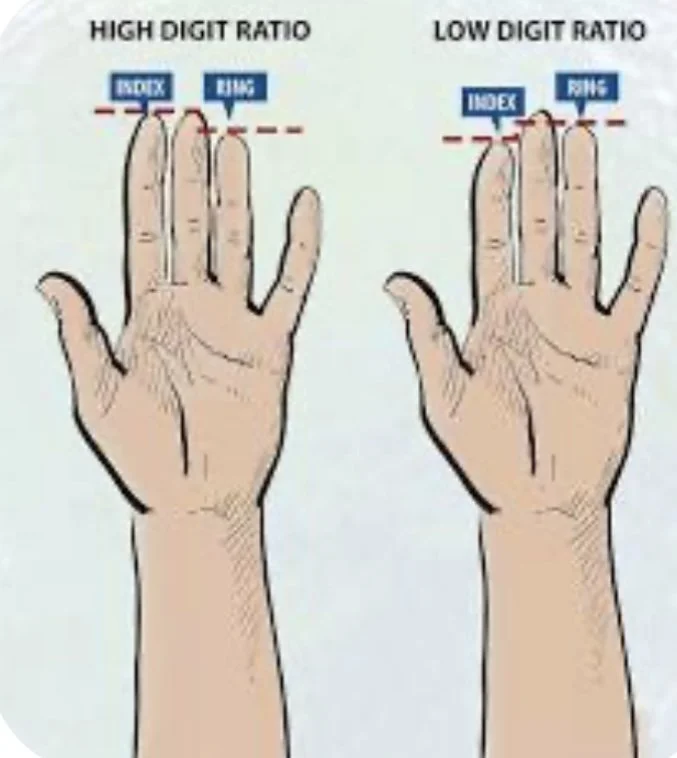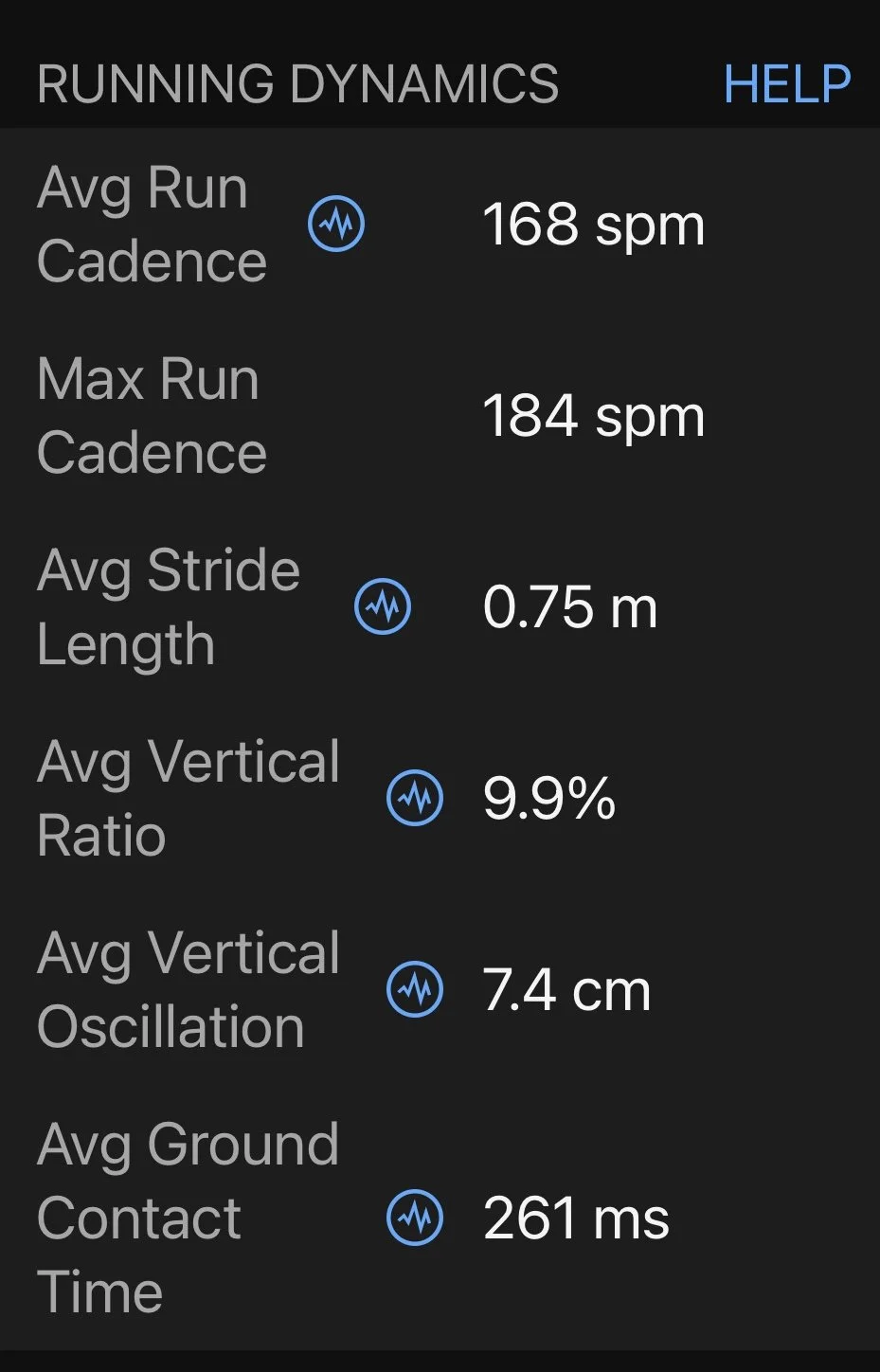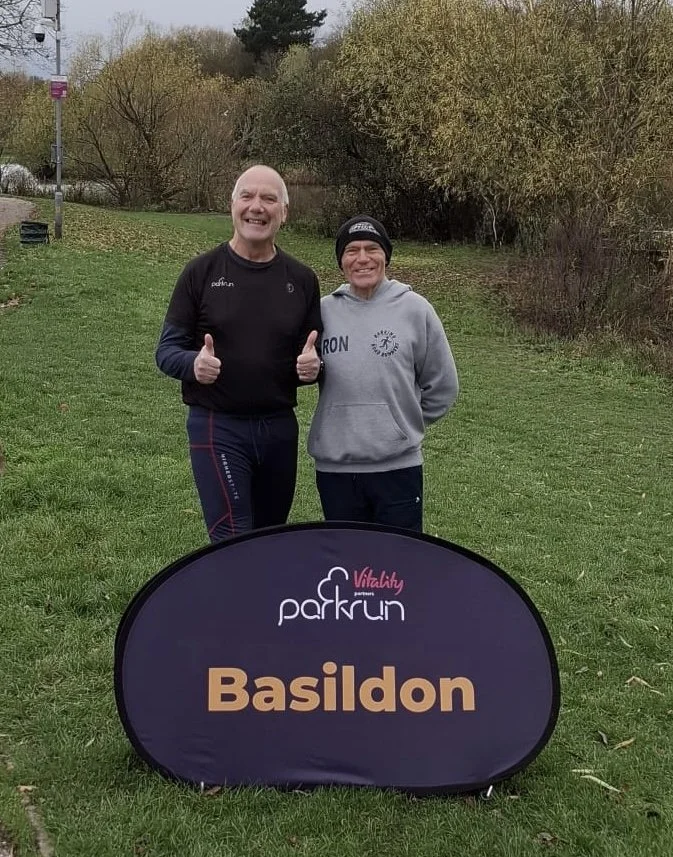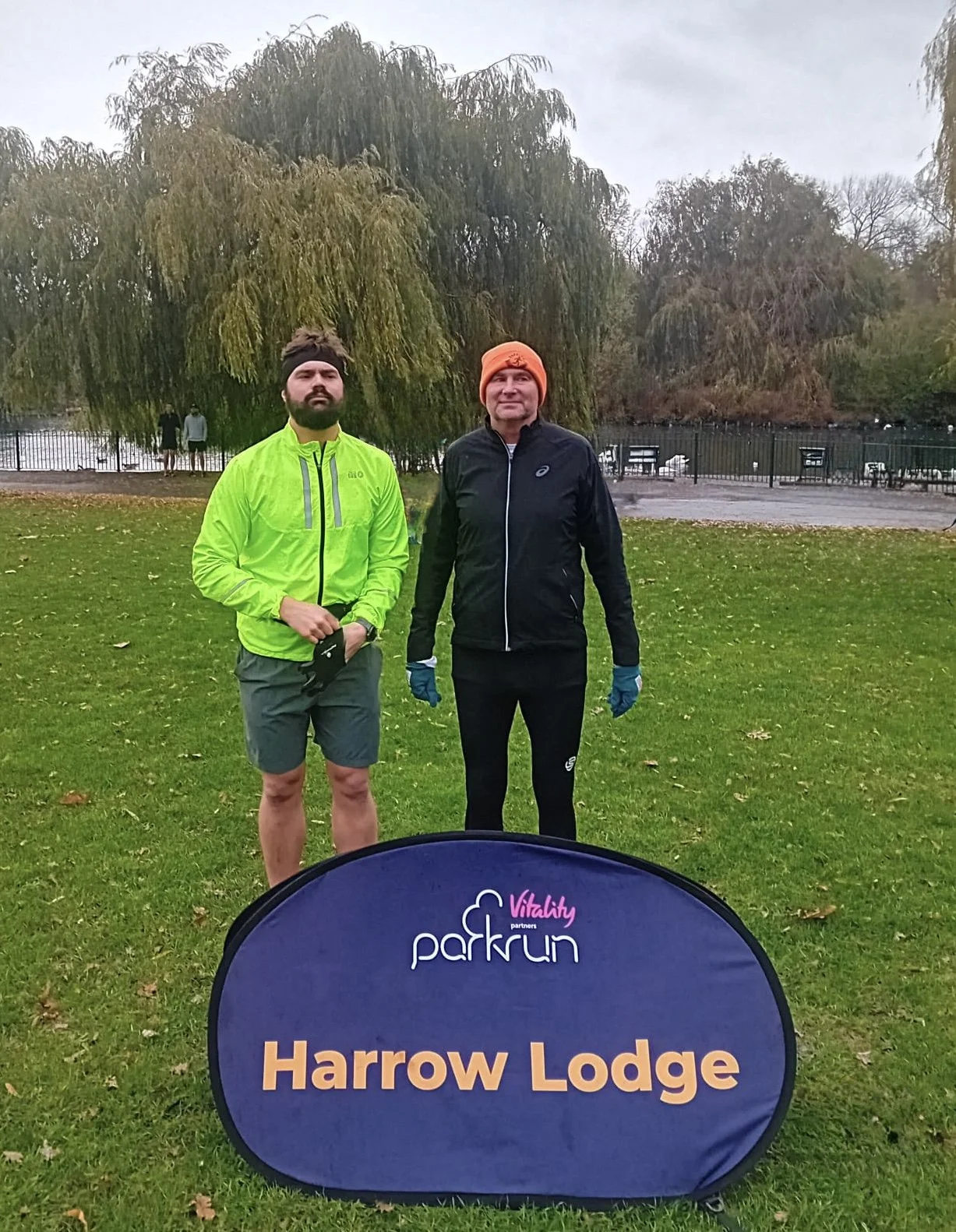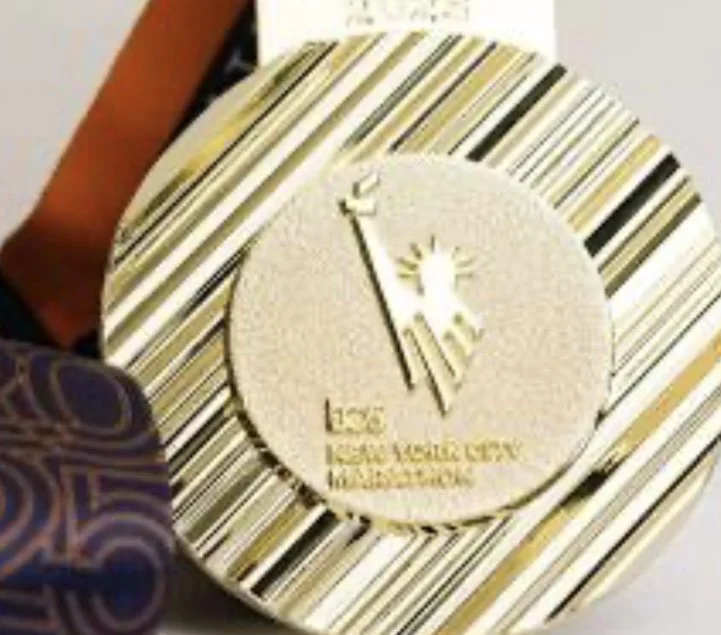BRR Blog - 24 November 2025
The BRR Team at Trent Park. Paul’s not really cold at all…
Hello Road Runners
Well, I suppose the mild weather couldn’t last forever! It was certainly the traditional arctic weather at the Chingford League in Trent Park on Saturday. Our international runners in San Sebastian seem to have had better temperatures but I expect they were just happy the race went ahead this year and wasn’t cancelled again.
It’s looking like we have drizzle to look forward to at Hockley Woods next weekend (see the BRR diary, below) but hopefully we will all have acclimatised to the dodgy weather by then!
November Committee Meeting
Club Secretary Isabel has been otherwise engaged with baby Ikenna for the past few weeks, so I’m afraid you have had to rely on me for this month’s Committee minutes. You can find them here.
Zahra’s Uni Unload
Nutrition is essential to think about as runners; it can be the difference between a good and a bad run. Now training for a marathon, I've realised I need to look into my nutrition and the data is surprising: it turns out you need 50-60% of your diet to be carbohydrates - that's a lot of carbs. Although that is a big number we need good carbohydrates that will keep us full for longer so options like oats are good as they are complex carbs so they give us sustained energy unlike simple carbs like candy which would give us a quick sugar crash. 30-60 minutes before a run you should be taking in some protein too, I think good options include eggs as well as beans and lentils and meat for those that eat it. We also need healthy fats which you get from things like avocados and olive oil. One thing that is good for after a run is chocolate milk because it has basically everything you need after a run including protein and lots of vitamins and electrolytes, with the added bonus of it tasting good. For runs over 75 minutes we need 30-60g of carbs per hour which we typically get from gels and energy chews like bloks. However, some people use things like candy and food to fuel their runs as a cheaper and tastier alternative. You have a 30 minute window after a run where you should re-fuel and you should aim for a 3:1 carb to protein ratio to replenish glycogen and repair your muscles.
Holey Running Top!
The Nike Radical Airflow running top
Eliud Kipchoge’s performance at his first, and likely last, New York City Marathon a few weeks ago wasn’t very notable for someone hailed as perhaps the GOAT (Greatest of All Time) marathon runner; the 41-year-old Kenyan finished 17th in 2:14:36, completing his run of all World Marathon Majors. More notable was the top that he wore for the race: a white, long-sleeved, string vest.
Perhaps ‘string vest’ is under-selling the garment. It was actually a one-off Nike prototype made from a new material called ‘Radical AirFlow’.
The knitted fabric of Radical AirFlow contains tiny, funnel-shaped air channels that are intended to direct air toward the skin as a runner moves, speeding up the evaporation of sweat. Or, as Nike’s ‘apparel innovation director’, Jahan Behbahany, put it, the fabric was designed to “accelerate the velocity of airflow to the skin and help speed up that evaporative cooling process.”
Kipchoge had been testing samples of the top for the past year at his training camp in Kaptagat, Kenya, providing feedback to Nike so they could improve the design. His suggestions included larger holes under the arms to improve airflow and a neater fit. His verdict on the finished article? “The material is wonderful, friendly to the skin, and absorbs moisture very fast. The magic of this top is how it evaporates the sweat.”
You will have to wait a little while to get your hands on the Radical Airflow top. Nike says it will launch to the public in spring 2026. In the meantime, I might get out my crochet hook and make my own.
Believe it or Not…
Vertical Oscillation
Talking of measurements, my running watch gives me statistics for vertical oscillation. I used to write the numbers down in my running diary until I realised: I didn’t have a clue what they meant and why they mattered!
Vertical oscillation (VO), also known as Vertical Bounce, is a measure of the distance your body travels up and down with each stride when you run. It is measured in centimetres. A runner with high vertical oscillation moves noticeably up and down with each stride, bouncing with every step. A runner with low vertical oscillation shows minimal upward and downward movement, with the top of their head staying relatively level throughout their stride. This difference reflects how much energy is spent moving vertically versus propelling forward during the gait cycle.
Clever sports watches are able to measure how much energy you expend upwards versus forwards. By using this information to make adjustments, you can improve your speed, endurance, and overall running performance.
What your vertical oscillation stats might look like
What Is a Good Vertical Oscillation Running?
“Good” VO is generally around 5 to 10 cm, but this varies from person to person and depends on the type of running you’re doing.
High VO in running, typically above 10cm, is inefficient because it wastes energy on upward movement rather than forward motion, reducing running economy and increasing oxygen use. Excessive VO causes runners to bounce more, heightening the risk of injuries as each foot strike generates greater impact forces due to a higher fall from the ground. This can lead to bone stress and joint injuries. In short, high VO means more energy spent bouncing rather than propelling forward, compromising efficiency and elevating injury risk.
Low VO in running, typically below 5 cm, is inefficient because it means there is little “flight” phase, causing a shuffling gait rather than true running. This leads to longer ground contact time, which slows running speed and may increase the risk of injuries like plantar fasciitis due to prolonged tension on the foot’s muscles and fascia. Additionally, low VO often results from very short, choppy strides, which further reduces efficiency and speed. Therefore, too little vertical movement can compromise both performance and injury prevention.
Common mistakes with vertical oscillation (VO) in running include excessive tension, lack of forward lean, pushing off too early, shuffling, and overly short strides. To improve, relax your knees and ankles, adopt a slight forward lean from the hips, and ensure your foot smoothly rolls before push-off. Avoid shuffling by lifting your feet lightly and strengthening your calves and glutes. Also, lengthen your stride with hip mobility exercises and drills like A-skips. These changes help smooth your stride, increase efficiency, and reduce injury risk.
A-Z of Running
Episode fifteen in the A-Z of running, and this week it is brought to you by the letter ‘O.’ Outstanding!
Obstacle Race: Race involving physical challenges and obstacles. Obstacle races can be good for adding variety to your training schedule, as well as helping to improve strength and agility.
Off-Road Running: Running on trails or uneven terrain. You may need to wear trail shoes, and watch your footing.
Onset of Fatigue: The point during a run when muscles begin to tire significantly. You can improve endurance and delay the onset of fatigue through gradual mileage increases and proper nutrition.
Optimal Cadence: Ideal steps per minute for efficient running. Tip: Aim for around 170-180 steps per minute.
Orthotics: shoe inserts designed to correct biomechanical issues and improve running comfort. They can be off-the-shelf or custom-made if you have complex issues with your feet.
Out-and-Back: A route where you run to a certain point and then return along the same path to finish where you started.
Overpronation: Excessive inward rolling of the foot during running, which can lead to injuries. Consider stability shoes or orthotics if you overpronate and it is causing you pain or injury.
Overdistance: Running farther than race distance in training. I’ve unpacked overdistance training a bit more, below.
Overtraining: condition caused by excessive training without adequate rest, leading to fatigue and decreased performance. It is important to make rest days a part of your running schedule and listen to your body to avoid overtraining. Sometimes less really is more!
Overuse Injury: Injury caused by repetitive stress without recovery. Cross-train and adequate rest reduces the risk of overuse injury.
Oxygen Debt: Condition when oxygen intake is insufficient during intense exercise. To improve aerobic capacity you need a structured approach that combines endurance-building strategies with progressive overload. Your training plan should include long, slow distance runs, tempo runs, and intervals. More on progressive overload next week…
Going the (Over)Distance
As mentioned in the A-Z, above, overdistance refers to running longer than your target race distance during training. For example:
If training for a 10K, you might do a 12–14 km long run.
For a half marathon (21.1 km), you might run 23–25 km.
For marathoners, some consider runs beyond 26.2 miles, though this is rare, for the reasons outlined in the risks and downsides, below.
Overdistance is often associated with Long Slow Distance (LSD) training, done at an easy pace in Zone 1–2 (low intensity). The goal is to build aerobic endurance, improve fat utilisation, and strengthen mental resilience for prolonged effort. You shouldn’t be blasting it out!
✅ Benefits of Overdistance Training
Aerobic Base Development - Improves oxygen uptake, capillary density, and mitochondrial function, making you more efficient at endurance efforts.
Fat Adaptation - Teaches your body to use fat as fuel, sparing glycogen for later stages of a race.
Mental Toughness - Builds confidence and trains your brain to handle fatigue and discomfort over extended periods.
Running Economy Under Fatigue - Helps recruit intermediate muscle fibres when slow-twitch fibres tire, improving efficiency late in races.
⚠️ Risks and Downsides
Injury Risk - Longer runs increase stress on joints and muscles, raising chances of overuse injuries like shin splints or stress fractures.
Recovery Time - Overdistance sessions require longer recovery, which can disrupt overall training consistency.
Diminishing Returns - Beyond a certain point, extra mileage offers little physiological benefit but adds risk (especially for marathons and ultras).
Overtraining - Excessive volume without adequate rest can lead to fatigue, immune suppression, and even heart strain in extreme cases.
So, overall, is it good or bad?
Good when used sparingly and strategically for shorter races (5K–half marathon) or early in a training cycle to build endurance.
Bad if done too often, too fast, too far, or too close to race day—especially for marathons or ultra distances, where recovery costs outweigh benefits.
Greg’s Race Report
Chingford League Round 3 for Barking Road Runners this week saw a small team compete in the 5-mile cross country race at Trent Park hosted by Barnet and District AC. Paul Withyman 32:20 was first finisher for BRR followed by Mark New 38:17 and Emma Paisley 45:58.
Several BRR members travelled to Spain for the San Sebastián 10k. First finisher for BRR was Martin Page in a time of 49:10 followed by Tom Brennan 50:28, Belinda Riches 54:32, Rob Courtier 1:06:29, Dennis Spencer Perkins 1:07:59 and Dawn Curtis 1:16:49.
The BRR crew in San Sebastian
BRR parkrunners
Barking - Joe Stacey 20:15, Rosie Fforde 24:01, John Mitchell 24:56, Jason Li 28:50, Nikki Cranmer 29:09, James Hall 30:02 and Alan Murphy 51:08.
Basildon - Ron Vialls 25:12 and Gary Harford 30:50.
Gary and Ron at Basildon parkrun
Brentwood - Louise Chappell 32:53.
Gunnersbury - Barry Rowell 28:40, Steve Colloff 33:06, Darren Graham 45:28 and Denise Graham 53:02.
Barry at Gunnersbury parkrun
Harrow Lodge - Rory Burr 26:15 and Stuart Burr 29:23.
Rory and Stuart and Harrow Lodge parkrun
Raphael - Doug King 26:57.
Valentines - Richard Dudman 28:36 and Kevin Wotton 33:48.
Highest BRR age gradings this week were Rosie Fforde 62.66% for the women and Ron Vialls 72.82% for the men.
BRR Diary - November/December
The highlights of the coming weeks are listed below but you can see the full diary of BRR events on the TeamUp app. Simply download the TeamUp app to your phone, then enter the calendar key: ks67p21gt8p5gzdo66 when prompted. If you don’t want another app on your phone, you can also find it under the ‘events’ tab on the Barking Road Runners website: https://www.barkingroadrunners.org.uk/calendar.
7.00pm, Tuesday 25 November - speed session. Jim Peters Stadium, Mayesbrook Park. Jess will be coach this week, and it’s the Goldilocks session:
3 x Baby Bears [1min run, 1min rec]
2 x Mummy Bears [2min run, 2min rec]
1 x Daddy Bear [4min run, 3min rec]
2 x Mummy Bears [2min run, 2min rec]
3 x Baby Bears [1min run, 1min rec]
7.15pm, Thursday 27 November - Club road run. Castle Green Centre, Gale Street, Dagenham. A social run around the pavements of Barking and Dagenham, usually around 4-5 miles long.
10.00am, Sunday 30 November - SECCL 02. Hockley Woods, B1013, Hockley, Essex, SS5 4RQ. Second race in the South Essex Cross Country League competition, organised by Rochford Running Club. Entry normally £5 but BRR members pay £3. Usually a nice cross-country run through the woods - not too much mud! There is a nice pub just outside the woods for a drink/lunch afterward.
7.00pm, Friday 5 December - Presentation Night. The Three Travellers, Wood Lane, Dagenham RM10 7DS. Time to celebrate club achievements over the past season, whether you are a trophy winner or not. Do come along for a great social evening with your clubmates. I wonder if we’ll rekindle the BRR tradition of a Christmas singalong…
7.30pm, Wednesday 10 December 2025 - Chingford League 03. Velopark, Queen Elizabeth Olympic Park, Abercrombie Rd, London E20 3AB. The second outing on the Stratford Velopark course this year! A three lap, 5k, race on the undulating outdoor cycle track in the Olympic Park. Separate male and female races. Senior Women and U15/17 girls and all U11/13 start 7.30pm (stampede!), Senior Men and U15/17boys start 8pm. Distances: U15/17/Seniors; measured 5k, U13/11s 2k (approx). Remember to bring your bib number, if you have one!
10:30am, Sunday 14 December - Southend Rudolph Run. Adjacent to Ness Road on the Esplanade, Southend-on-Sea, Essex, SS3 9HG. A fun 5-mile run along the Esplanade. Fancy dress is not compulsory but you might feel like the odd-one-out if you’re not at least wearing a Santa hat. The plan is to go for lunch afterwards , if you are free. https://www.nice-work.org.uk/e/southend-rudolph-run-9240
Cracker Corner
A fly tried to land on my wrist. I thought ‘not on my watch.’
I replaced my car engine with a washing machine motor. I’m just going to take it for a spin.
Does anyone know how to sort out the condensation in my kitchen? If so, pop round; the kettle’s always on.
Quote of the week
“Running has given me endless rewards: physical, emotional, and professional. The benefits of running are lifelong.”
Grete Waitz
nine-time New York Marathon Champion
And finally
For sale: the 2025 New York Marathon medal
There was controversy a few months ago, when the 2025 Great North Run medal featuring ‘the wrong river’ started being sold on eBay. But it seems this isn’t just a phenomenon in the UK. Within hours of the 2025 New York City Marathon finishing, finisher medals began popping up for sale on eBay in the US. For some – like our very own Cristina - I’m sure these shiny, gold-toned, medals are cherished reminders of a fantastic personal achievement; for others, they’re collectibles with resale value. Recent listings show sellers asking anywhere from $80 to $125 for a 2025 medal.
But it’s not just the latest medals drawing attention. Scroll through eBay and you’ll encounter vintage medals on sale too: a 1986 NYC Marathon medal recently fetched $205. Not sure what Grete Waitz would think of that.
However, before you start sorting through your old medals to see which you could make a fast buck with, note that despite dozens of active listings, the “sold” filter reveals only a handful of successful sales, suggesting the market is not as buoyant as it may appear. Still if, like mine, your old medals are just gathering dust in a carrier bag, it might be worth a go…
Happy Running!
Alison
Chair, Barking Road Runners
